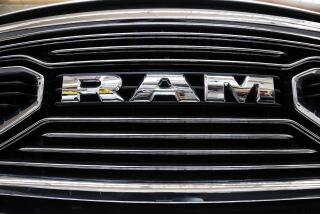GM, Isuzu Bet on Future of Diesel in U.S.
- Share via
DETROIT — In the face of public skepticism and environmental concerns, General Motors Corp. and Isuzu Motors said Wednesday that they will jointly build a $300-million diesel engine plant in Ohio.
The 650,000-square-foot factory will replace a smaller, aging diesel engine plant in Moraine, Ohio, that GM had threatened to close and move to Mexico, where labor costs are lower and work rules more flexible.
The project is the latest evidence that U.S. auto makers and engine manufacturers are mounting a major effort to revive diesel engines in this country to improve fuel efficiency and reduce greenhouse-gas emissions.
The bet on diesel engines, however, is a gamble, with public acceptance and government regulation the wild cards.
Diesels are popular abroad, where the fuel is cheaper than gasoline. But most U.S. drivers have never taken a shine to diesels. Despite technological advances that have improved performance, many Americans still associate the engines with noisy, sluggish and smelly vehicles.
At the same time, regulators are grappling with links between diesel emissions and health problems, including respiratory ailments and possibly cancer. Last month, the California Air Resources Board classified diesel soot as a toxic air contaminant that will be subject to tight regulation.
GM, the world’s largest auto maker, played down the environmental questions surrounding diesel engines, saying the new 6.6-liter, direct-injection power plant designed by Isuzu will meet all emissions regulations. It will mostly be used in large pickup trucks--those weighing more than 8,500 pounds and typically used to tow trailers or other large loads.
The new engine will emit 70% fewer particulates and 90% fewer smog-producing pollutants than diesels produced 10 years ago, he added, and will be 30% more fuel-efficient than comparable gas fuel engines while performing smoothly and quietly, but powerfully.
Jason Mark, transportation analyst for the Union of Concerned Scientists, opposes widespread diesel use because the engines emit harmful soot and more smog-producing emissions than other vehicles. But he says Detroit wants diesel engines in millions of passenger vehicles as a means of cheaply meeting federal fuel economy standards.
GM says the new plant will be the most modern diesel engine facility in North America. It plans to begin production in the third quarter of 2000. When completed in 2004, the plant will build up to 200,000 engines a year. GM now produces about 70,000 diesel engines in Ohio.
The project shows how GM is leveraging its global resources to develop new engines quickly and cost-effectively. The joint venture is the first major project launched since GM announced a year ago that Isuzu would take over its diesel-engine development as part of a global reorganization of its powertrain operations.
Japan-based Isuzu, which has worked with GM since 1971, is the world’s largest maker of diesel engines, producing 710,000 units worldwide last year. It will control 60% of the joint venture and be responsible for the design and engineering of the new engines.
GM, which owns 37.5% of Isuzu, will control 40% of the venture. It is financing the operation and will oversee the day-to-day manufacturing operations.
The new factory will employ 700 workers, most of whom will be transferred from the existing plant. The workers are represented by the International Union of Electrical Workers, which agreed to a tiered wage scale that starts new workers at a lower wage.
Arv Mueller, vice president of GM’s powertrain operations, said the union’s flexibility with both wages and work rules was a major factor in the decision to build the plant in Ohio.
The new V-8 engines will be aimed at GM’s heavy-duty pickup trucks but can also be used in its full-size sport-utility vehicles and vans. There are no plans to use the engines in other vehicles, though GM officials said smaller versions could be easily adapted for passenger cars if consumers demanded it.
Auto makers, engine suppliers, oil companies and the federal government are all intensifying research into diesel engines as the push for fuel economy and lower emissions of global-warming gases intensifies.
For instance, Detroit Diesel, an engine manufacturer owned by Penske Corp., last month unveiled a new V-6 engine for light trucks, its first attempt to enter the passenger vehicle market.
All of the Big Three have shown interest in diesels as a way to help them meet fuel economy standards for pickups, sport-utilities and minivans. They are also trying to develop advanced electric-diesel hybrids that get up to 80 miles a gallon under a research program with the federal government and national laboratories.
Ford Motor Co., the leading user of diesels among the Big Three, makes about 200,000 light trucks a year powered by diesel engines from Navistar International Corp. Chrysler Corp. sells about 60,000 units a year of its Dodge Ram full-size pickup trucks with diesel engines made by Cummins Engine Co.
Still, the penetration of diesel engines in the United States is only about 1% of light vehicles (down from 6% in the early ‘80s), compared with 25% in Europe.






